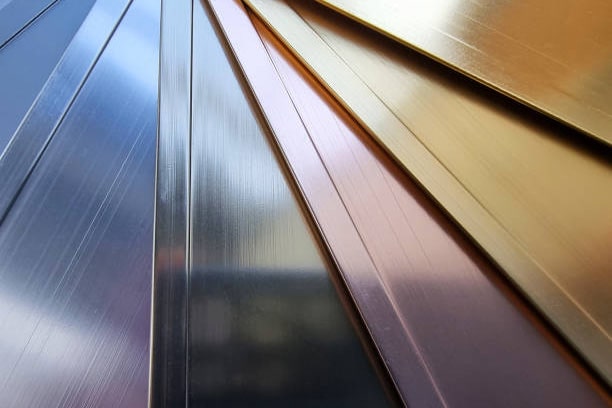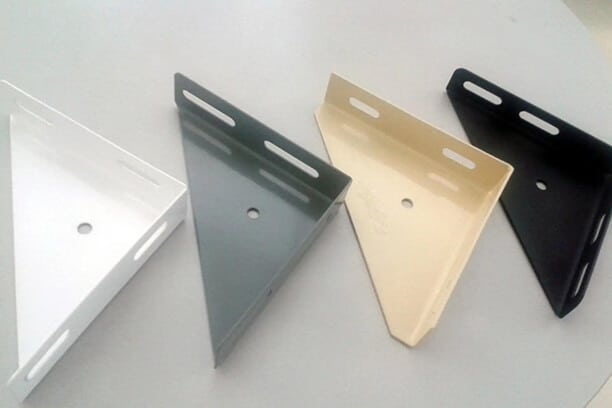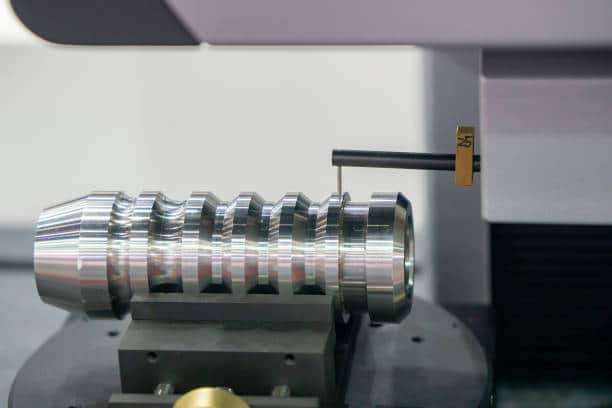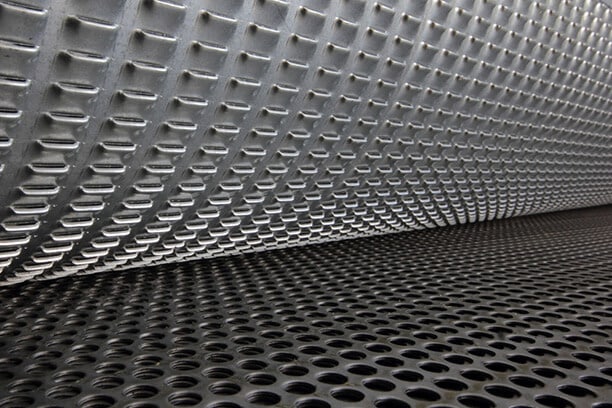Stainless steel finishes provide a multitude of advantages, involving the use of fabrication processes to improve the surface characteristics of the metal. Finishes are applied to achieve exceptional attributes such as durability, corrosion resistance, reflective surfaces, smoothness, or specific grain patterns, depending on the ultimate end-use requirements.
Stainless steel can undergo various finishing techniques such as mill, brushed, patterned, polished, colored, or decorative treatments. Choosing an appropriate finish for your specific application is crucial. It ensures stainless steel with a long lifespan, excellent corrosion resistance, and low maintenance needs. The right finishing process assures the desired behavior of stainless steel.
This guide explores stainless steel finishes in four main types for your practical use and lists the two most recognized standards: EN and ASTM, and offers some tips on product options, proper technique, and usage that may help you.
Types of Stainless Steel Surface Finishes
Although there are variations within each of the options, the more typical categories of stainless steel finishes are mill finishes, patterned finishes, brushed and polished finishes, and colored finishes.
Mill Finishes
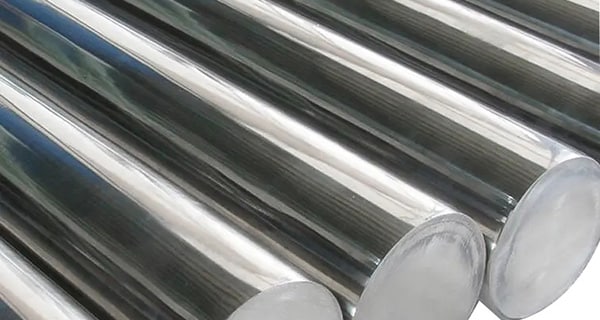
All stainless steel sheet products come with these finishes as the basic supply condition, whether they are hot or cold rolled. They are widely employed in various applications and are utilized as the initial stage for mechanical polishing and other finishing processes. To ensure the highest possible corrosion resistance, most undergo acid cleaning (pickling) to get rid of any scaling created during the hot rolling and annealing processes, except in the case of a bright annealed finish.
No. 1 Finish
To achieve No. 1 finishes in stainless steel, the material must undergo hot rolling until it reaches the desired thickness. These finishes generally appear dark and varied, and they display the roughest and least uniform surface texture among all stainless steel finishes. Therefore, they are most appropriate for applications where aesthetics are of the lowest priority, and they are frequently followed by pickling to improve their corrosion resistance.
However, No.1 finishes have a major downside in that they do not possess a reflective surface, rendering them inadequate for applications that require brightness, appearance, and texture.
No. 2B Finish
To attain a No. 2B finish in stainless steel, the material is put through special rolls or dies during a process known as cold rolling. This cold rolling method produces a surface that is smoother and less pitted in appearance. The softened stainless steel is then subjected to an acid solution to remove any rust or scale buildup. Finally, the steel is given a final pass on polished rolls to strengthen its overall smoothness.
Compared to other options, No. 2B matte finishes offer a more affordable solution in stainless steel finishing. They are typically used in cookware, small tanks, and pharmaceutical equipment as a general-purpose cold-rolled finish.
No. 2D Finish
A No. 2D finish is achieved through a similar process as a No. 2B finish, involving cold rolling, annealing, and pickling. However, this finish possesses a duller and matte quality. It’s particularly well-suited for deep drawing purposes and can be found in a variety of products, such as automotive exhaust components, chemical equipment, and hardware.
Bright Annealed (BA) Finish
To achieve a bright annealed finish, stainless steel is first cold-rolled and then annealed in a controlled and oxygen-free environment to prevent any scaling during the annealing process. Since a thin oxide film forms during annealing, there is no requirement for pickling the finish in acid. This type of finish is generally utilized in cookware, trim appliances, and surgical instruments.
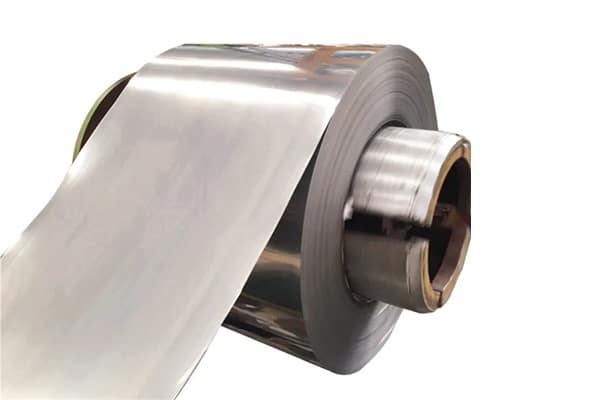
TR Finish
A TR (Temper Rolled) finish is achieved by cold rolling an annealed surface to enhance mechanical properties, which results in varying appearances depending on the alloy and the degree of cold work applied. Examples of such finishes include quarter hard, half hard, and full hard. The final effect of the stainless steel surface is smooth and reflective.
2Q Finish
The 2Q surface finish is designated by EN for stainless steel and is similar to the TR finish because it involves cold rolling and subsequent hardening. However, unlike the TR finish, the 2Q finish is hardened and tempered in a protective environment or descaled after heat treatment. This surface finishing option is tailored for use on martensitic steels, which are the sole type of steel to respond to these treatments.
This finish typically has a smooth surface without any scaling, making it well-suited for use in the automotive and medical industries as a surface finishing option.
Patterned Finish
To create patterned stainless steel finishes, patterned rolls are utilized for pressing or rolling. This technique results in a sheet that is effectively reinforced, enabling the use of thinner gauge cladding, leading to potential cost savings and reduced weight. Additionally, the pattern can be applied on one or both sides to achieve double-sided patterned stainless steel.
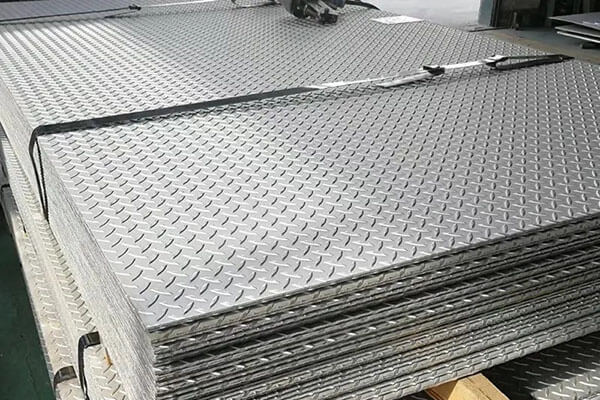
The table below outlines some of the patterned finishes in EN standards and their corresponding ASTM equivalents along with their features.
| EN Designation | ASTM Equivalent | Type of Finishing | Features |
| 2F | No. 2D | Patterned Finish | Cold-rolled, bright annealed, or annealed and pickled; A uniform non-reflective matt surface. |
| 1M | None | Patterned Finish | The design will be determined upon mutual agreement; One side of the plate is flat; The plates are intended to be used on floors. |
| 2M | None | Patterned Finish | The design will be determined upon mutual agreement; One side of the plate is flat; The fine texture is primarily utilized for architectural purposes. |
| 2W | None | Patterned Finish | The design will be determined upon mutual agreement; The plate features corrugated texture on both sides, providing additional strength and/or aesthetic appeal. |
Mechanically Brushed and Polished Finishes
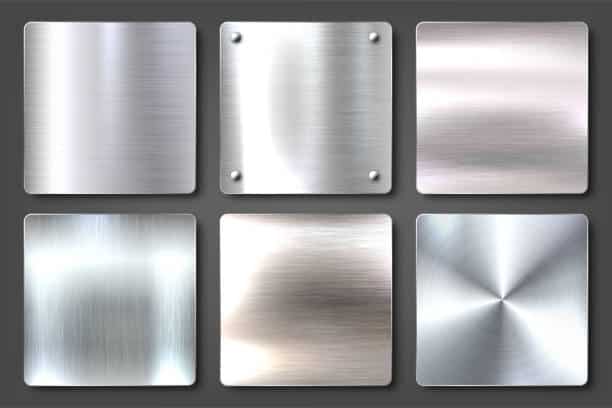
No. 3 Finish
The No. 3 surface finish is an ASTM designation that corresponds to the 1G-2G finish in EN standards, achieved through a grinding process. The 1G implies a starting point of hot rolling, while the 2G indicates starting with cold rolling.
Surface roughness of up to 1 micrometer is typical in the No. 3 surface finish, which results in a surface with low reflectivity. This type of finish is commonly used for kitchen equipment, parts in food processing plants, etc.
No. 4 Finish
A No. 4 finish provides a refined surface quality that is created by processing the stainless steel with polishing belts and brushes. This process results in a slightly reflective surface with a uniform directionality. The ultimate roughness of the finish depends on the grade of brush used and the quality of the polishing belt utilized.
The No. 4 finish is recognized for its unique appearance, showcasing a muted color and the presence of very fine lines. This finish is ideal for decorative purposes that do not require high levels of reflectiveness. The major downside of this type of stainless steel finish is its reduced ability to resist corrosion.
No. 6 Finish
To achieve a No. 6 finish, a No. 4 finish is treated with Tampico brushing. This results in a dull silver-white appearance that has less reflectivity than a No. 4 finish.
This finish has excellent corrosion resistance and can be modified to meet specific corrosion resistance requirements for marine and external architectural applications. Although it was commonly used on stainless steel architectural components until the 1980s, it is not as commonly used today.
No. 7 Finish
A No. 7 finish is a buffed finish achieved by buffing a finely ground surface, which has a highly lustrous appearance while still showing visible grit lines on the material. This finish is extremely reflective, almost like a mirror, and is often used for column covers, ornament trim, and wall panels.
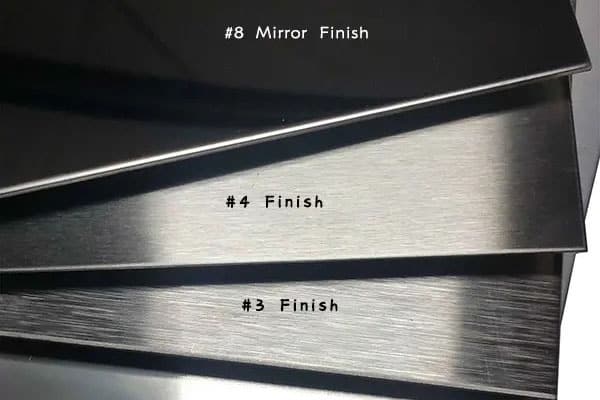
No. 8 Finish
The No. 8 finish is achieved by using a series of increasingly fine abrasives to mechanically treat the surface. Alternatively, a special rolling procedure that mimics mechanical abrasion can also produce the desired effect. At this stage, it is crucial to eliminate deep scratches because any surface defects will be easily visible on the finished product. The final step involves buffing the surface for a period of 5-10 minutes to produce a highly reflective, mirror-like finish.
The No. 8 mirror finish offers the advantage of enhancing the corrosion resistance of the material. The polishing process smooths out crevices where corrosive particles can potentially settle.
Colored Finishes for SS
Utilizing the qualities of the inert chromium layer present on the surface of stainless steel, these finishes confer corrosion resistance to the material.
Moreover, the chromium layer can be easily colored using chemical processes and subsequently hardened through electrolysis, creating a type of finish known as electrolytically colored finishes.
When required for a specific application, these stainless steel finishes can also be patterned.
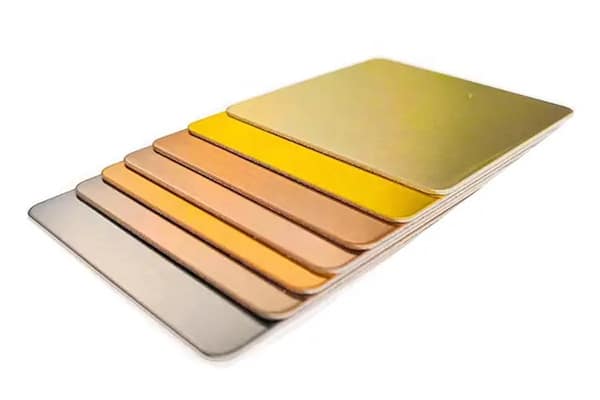
2L Finish
The 2L is the most prevalent surface finish and is the designation for all colored surface finishes on stainless steel. There is a broad range of colors available.
Typically, these finishes are utilized for decorative or ornamental purposes, while occasionally the colored finish is implemented to match with other materials in intricate designs.
Custom SS Finishes
Customized metal surface finishes offer specific characteristics that are not attainable through standard finishes. These finishes are customized to your unique application and vary significantly based on your specific designs.
For example, it’s possible to combine two or more surface finishes to achieve unique aesthetic or functional properties.
Consequently, you may have stainless steel with embossed or etched patterns, as well as non-directional patterns.
This chart concludes the main features of different types of surface finishing for stainless steel.
| Type of Finishing | ASTM Designation | Characteristics |
|---|---|---|
| Mill Finish | No. 1 | Hot-rolled, annealed, and passivated. |
| No. 2B | Cold-rolled, annealed, pickled, and passivated, and further passed through highly polished rollers. | |
| No. 2D | Cold-rolled, annealed, pickled, and passivated. | |
| TR | Work hardening and cold working for higher strength, a bright surface. | |
| BA | Cold-rolled, bright annealed, and skin-passed, a smooth, bright, and reflective surface. | |
| Brushed and Polished Finish | No. 3 | Ground, the grit grade or surface roughness can be customized, a unidirectional texture and lack of high reflectivity. |
| No. 4 | A brushed or dull polished finish; the grade of brushing, polishing belt, or surface roughness can be customized. It has a unidirectional texture and lacks high reflectivity. | |
| No. 6 | A satin polish finish, and additional specific requirements are needed for a J-type finish to ensure high corrosion resistance in marine and external architectural applications. | |
| No. 7-8 | A true mirror finish; the process or surface roughness can be customized. It has a non-directional finish and is highly reflective with excellent image clarity. |
EN and ASTM Equivalents for SS Finishing
Here, we summarize the surface finish designations in EN standard and its corresponding ASTM standard in a table format.
| EN Designation | ASTM Equivalent | Type of Finishing |
|---|---|---|
| 1D | No. 1 | Mill Finishes |
| 2B | No. 2B | |
| 2D | No. 2D | |
| 2H | TR | |
| 2R | BA | |
| 2Q | None | |
| 2F | No. 2D | Patterned Finishes |
| 1M | None | |
| 2M | None | |
| 2W | None | |
| 1G-2G | No. 3 | Brushed and Polished Finishes |
| 1J-2J | No. 4 | |
| 1K-2K | No. 6 | |
| 1P-2P | No. 7-8 | |
| 2L | None | Coloured Finishes |
Tips for Finishing Stainless Steel
Before starting to grind and finish stainless steel, it’s essential to receive the necessary training and be familiar with how stainless steel reacts. Apart from selecting a product suitable for your application and desired finish, adhering to proper techniques, product selection, and usage is critical. Here are some helpful tips:
1. Abrasive Options Based on Finishing Requirements
There are several common finishes available for stainless steel, including non-directional, No. 4 finish, and mirror polish. When selecting an abrasive, it is necessary to consider the visual or roughness average (Ra) finish requirements. For rough grinding, a 36- or 40-grit flap disc is suitable.
However, if a mirror polish is required, a higher grit abrasive and buffing compounds or fiber wheels are necessary to achieve the desired visual finish. An abrasive specifically designed for stainless steel will be more effective, as it cuts faster, lasts longer, and better dissipates heat compared to one made for carbon steel.
2. Avoid Cross-Contamination in SS
Merely being labeled for use with carbon steel or stainless steel does not guarantee that a product is free of contaminants. A product that is considered contaminant-free should contain less than 0.1% of iron, sulfur, and chlorine, as these elements can lead to oxidation.
Inox products are free of contaminants. Whether you need a contaminant-free product or not depends on what you need for your application. It is vital to avoid using the same tool on stainless steel after using it on carbon steel to prevent the introduction of contaminants. Color-coded abrasive products can help distinguish between tools and avoid mistakenly using the wrong tool.
3. Start with the Desired Finish on the Parent Material
To save time and money, many operations begin with a base material that has already been prefabricated to the desired specifications. It’s a common practice to have a sheet metal base piece finished by a machine with a No. 4 directional finish or mirror polish before the welding operation. This reduces the amount of manual finishing required after the pieces are welded together.
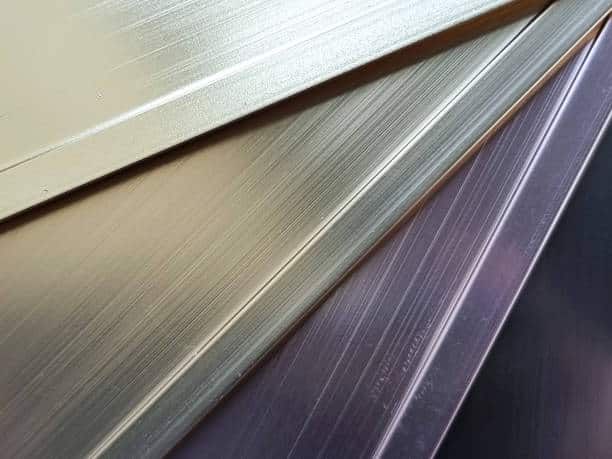
4. Avoid Applying Excessive Pressure
Abrasive products generate heat during use, which can more easily damage stainless steel compared to carbon steel. Reducing pressure and letting the abrasive brush or disc do the work as intended is an effective way to minimize heat during grinding or finishing.
5. Use A uniform and Consistent Pattern
It is vital to maintain a consistent and uniform pattern when grinding or finishing stainless steel. Spending an extended amount of time in a single area can cause heat buildup, potentially resulting in damage to the base metal and additional time spent on rework.
6. Document SS Finishing Process
Creating a step-by-step process for finishing stainless steel is critical to ensuring consistent outcomes. The documentation can eliminate guesswork and minimize rework, which is especially crucial when specific finishes are necessary and must be measured each time – for instance, in medical or food processing applications. Documented processes should detail the specific abrasives used, their grit, and the corresponding steps involved.
Your Part Finishing Solution Provider – Runsom Precision
At Ransom Precision, we work with the most commonly used stainless steel grades and provide optimal finishes across various stainless steel formats. Our exceptional part finishing services extend to plastic, composite, and metal surfaces, and our facilities are equipped with top-notch machines and infrastructure to transform your prototype or envisioned part into reality. Request an instant quote today to get started with your metal finishing projects.
Other Articles You May Be Interested in:

